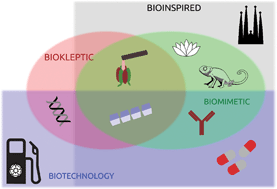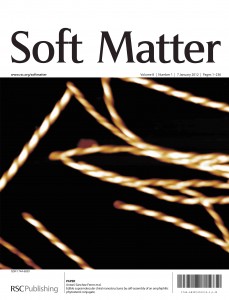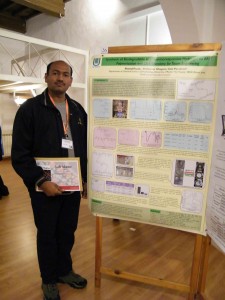This month sees the following articles in Soft Matter that are in the top ten most accessed for June:
Magnetic emulsions with responsive surfactants
Paul Brown, Craig P. Butts, Jing Cheng, Julian Eastoe, Christopher A. Russell and Gregory N. Smith
Soft Matter, 2012, 8, 7545-7546
DOI: 10.1039/C2SM26077H
Chemical approaches to synthetic polymer surface biofunctionalization for targeted cell adhesion using small binding motifs
Guillaume Delaittre, Alexandra M. Greiner, Thomas Pauloehrl, Martin Bastmeyer and Christopher Barner-Kowollik
Soft Matter, 2012, 8, 7323-7347
DOI: 10.1039/C2SM07407A
Design and properties of supramolecular polymer gels
Atsushi Noro, Mikihiro Hayashi and Yushu Matsushita
Soft Matter, 2012, 8, 6416-6429
DOI: 10.1039/C2SM25144B
Static wetting on deformable substrates, from liquids to soft solids
Robert W. Style and Eric R. Dufresne
Soft Matter, 2012, 8, 7177-7184
DOI: 10.1039/C2SM25540E
Mechanics of morphological instabilities and surface wrinkling in soft materials: a review
Bo Li, Yan-Ping Cao, Xi-Qiao Feng and Huajian Gao
Soft Matter, 2012, 8, 5728-5745
DOI: 10.1039/C2SM00011C
Model, self-assembly structures, and phase diagram of soft Janus particles
Zhan-Wei Li, Zhong-Yuan Lu, Zhao-Yan Sun and Li-Jia An
Soft Matter, 2012, 8, 6693-6697
DOI: 10.1039/C2SM25397F
The conundrum of gel formation by molecular nanofibers, wormlike micelles, and filamentous proteins: gelation without cross-links?
Srinivasa R. Raghavan and Jack F. Douglas
Soft Matter, 2012, 8, 8539-8546
DOI: 10.1039/C2SM25107H
Biocompatible and biodegradable polymersomes as delivery vehicles in biomedical applications
Gong-Yan Liu, Chao-Jian Chen and Jian Ji
Soft Matter, 2012, Advance Article
DOI: 10.1039/C2SM25721A
A novel technique for micro-patterning proteins and cells on polyacrylamide gels
Xin Tang, M. Yakut Ali and M. Taher A. Saif
Soft Matter, 2012, 8, 7197-7206
DOI: 10.1039/C2SM25533B
Wet granular matter: a truly complex fluid
Stefanie Strauch and Stephan Herminghaus
Soft Matter, 2012, 8, 8271-8280
DOI: 10.1039/C2SM25883H
Why not take a look at the articles today and blog your thoughts and comments below.
Fancy submitting an article to Soft Matter? Then why not submit to us today!
To keep up-to-date with all the latest research, sign up for the Soft Matter e-Alert or RSS feeds or follow Soft Matter on Twitter or Facebook.













 Congratulations to Sharad Pasale for winning a Soft Matter poster prize at the recent 3rd International Congress on Biohydrogels.
Congratulations to Sharad Pasale for winning a Soft Matter poster prize at the recent 3rd International Congress on Biohydrogels.